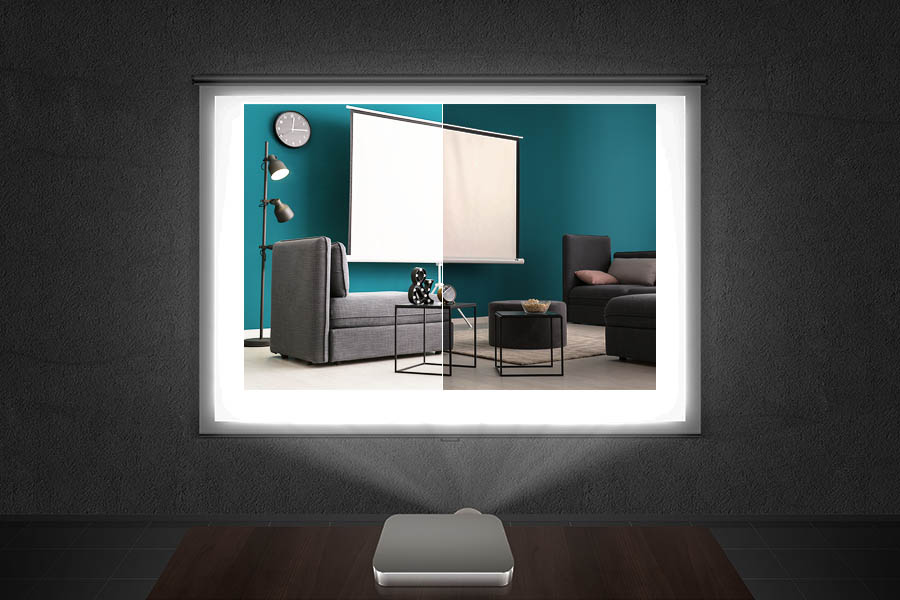There are many different things to think about when you’re setting up your own film area. Whilst finding the best projector screen is definitely of importance, you need to consider what type of screen you actually need.
You’ve probably seen the term “screen gain” used online, and most people aren’t exactly sure what it means. Although it might appear to be confusing, it’s actually pretty easy to understand. And knowing what screen gain means will help you to choose the right screen that’s compatible with your projector.
The truth is that the screen surface you opt for is likely more important than you think. When you want to be able to see the projected image clearly, then it is important to take this into account. So, let’s look to learn a little more about screen gain.
What is projector screen gain?
Screen gain is quite simply the brightness of the image that you’re projecting, which is determined by the projector screen’s surface. It is a measurement of the reflectivity of the screen at a zero degree viewing angle, which is directly in front of the screen itself.
Screen gain indicates how many lumens the image you’re viewing on the screen is. So for example, if you have a screen gain of 1.0, and a projector that has 3000 lumens of brightness, then the image that you’re going to see is 3000 lumens in brightness.
However, if you’re using a screen with a lower gain, then the brightness that you see will be less. It can essentially be used like a multiplier – a 1.0 gain projection screen will give you 1x whatever the lumens or brightness of your projector is.
So, if we use that same multiplying method, that same 3000 lumen projector on a 0.8 gain screen will only be seen as 2400 lumens. And similarly, if you’re using a screen with a higher gain, then you’re going to end up with a brighter image.
A 3000 lumen projector used with a screen with a gain of 1.1 is going to result in a 3300 lumen image being displayed. As the gain increases or decreases, so does the brightness of your projection. The projector surface is much more important than most people think.

Simple, right? Well, this is the basic answer to the question, but there is a little more to it than that. If you’re not sure whether you should opt for a high gain or a low gain screen, then let’s look at some of the benefits and drawbacks of using a high or low gain screen.
Pros and Cons of a High Gain Screen
There are some benefits to using a high gain screen, especially with a less powerful projector. The most common concern is that if you view the screen from a half gain viewing angle (which is 45° off centre, also called the viewing cone), then this may impact your viewing experience too much.
Let’s take a look at a few of the pros of using a high gain projection screen, as well as the drawbacks too.
Pros
At the very high end, you can find screens with a gain of more than a 3.0 or 4.0 surface. For a standard screen that’s going to be used with moderate ambient light reflecting onto it, you’ll probably want to look for a screen with a 1.5 gain or more.
Cons
Pros and Cons of a Low Gain Screen
In some scenarios, a low gain screen might actually prove to be the better choice. Much of this will depend on the amount of light that is actually being allowed into the area that you’re using. Here are some pros and cons to using a low gain screen.
Pros
The average person is going to want to opt for a neutral gain with their projector screen. This will produce adequate contrast and black levels whilst being used with minimal light, which is what most people will be looking for.
Cons
Conclusion
In conclusion, it’s actually pretty easy to understand what screen gain is. If you’re looking to project outside or in daylight, then a high screen gain might be the best way for you to project enough light to be displayed clearly.
However, if you’re always watching films in a darker condition, then a neutral or even negative gain could prove to be the better choice. It all depends on the environment you’re going to be using your projector screen.
Either way, as well as the brightness of your room, you’ll also want to think about the viewing angles that you’re watching the screen at. The closer you are to directly centre of the screen, the less the gain is going to matter.